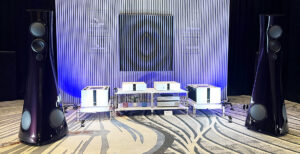
Hi-Fi+: How did you become interested in headphone design in the first place? What attracted you to this product category?
Igor Levitsky: Thank you for the opportunity to share my thoughts with your readers. This is very exciting. Well, I started R&D in planar magnetic technology in 1986 as a young engineer in the loudspeaker and headphone department of a large audio and acoustics design company back in the USSR ( in a city that is now in Ukraine). Our team made a breakthrough in developing an interesting concept for high efficiency planar magnetic headphones that went into limited production in the early 90s and sold in Eastern Europe. Over the years I have been working with a few partners that were interested in this technology, but it never worked out in the end for various reasons of a business nature.
Around 2006-2007 the market started to change with personal and computer audio gaining popularity and general audio market share. I felt the opportunity. I am an engineer and there is nothing more satisfying for me than overcoming challenges and creating new, exciting, and unique products that people would want to buy and enjoy. I must say that headphone design is very different and on some level more challenging than loudspeaker design. I was looking for opportunity to get the technology and the know-how out into the market. The moment has arrived when I met with folks from Oppo Digital (Oppo-rtunity). Oppo’s attitude, culture, and strategic goals were all hitting the right places for me and we started working overtime to get things rolling.
Hi-Fi+: As you work to create new top-tier headphone products, what are the top design objectives you try to bear in mind?
IL: Well, excellent question. Without a doubt, for a top-level headphone, sound quality is the most important. If we talk about a real life headphone, not just a lab device for short term comparative sessions, then the second top objective for me is to make sure it is enjoyable to use in real life conditions for prolonged periods of time. This is mostly related to comfort (weight, construction), ergonomics, and, to some extent, to industrial design, feel, and appearance. You know, I am convinced that a listener needs to feel good, excited, and positive when handling and wearing headphones. It is all related. I don’t think one can completely psychologically dissociate all the above factors from sound quality.
Some hard-core enthusiasts would say that they don’t care about all those “secondary” factors, but reality shows that this is not true for most people. Manufacturers that ignore these “other” factors are forced eventually to solve comfort and other design problems no matter what.
Other factors, I would say, are truly secondary in the case of top of the line models. Surprisingly, even price seems not to be that important nowadays if a headphone can sound truly exceptional.
Hi-Fi+: What technologies and product configurations best enable you to meet your design objectives?
IL: It all depends on the objectives. The set of solutions and tricks is different every time. Each headphone has its own…. how to say, “personality”. The design process is fascinating. It is not quite “linear” as for some other audio products. Oppo’s PM-1 headphone had one set of design objectives and the PM-3 had a different set. The PM-3 turned out to be a more difficult project since a truly portable headphone design imposes many additional limitations and requirements on top of the main goal – sound quality.

In terms of general approach, I am convinced that planar magnetic technology is the best overall solution for the majority of customers who demand high quality and high-resolution sound. It possesses many inherent advantages over traditional dynamic driver technology.
For most “stay at home” applications, an over the ear, open back design is the best. With PM-3 I had to go with a smaller size 55 mm driver, along with many other mechanical solutions aimed at weight reduction and increased comfort on the go. It is also an over the ear design with a closed ear cup configuration to reduce external noise for use outdoors or in office environments.
Hi-Fi+: Do you favour particular types of drive units for use in your designs and, if so, why?
IL: With very rare exceptions, only thin film based transducers can offer exceptional sound quality and resolution. Planar magnetic drivers inherently have much lower distortion than traditional drivers. They uniquely combine the best qualities of thin film transducers (shared to some extent with electrostats) and yet can be truly portable or at least transportable. They do not require a special desktop bias power supply and amplifier as electrostatic headphones do.
In many ways, electrostats are almost ideal for use in a very quiet room. For me, besides some issues with bass reproduction, several of the best models of electrostats are truly exceptional. However, when one starts looking at their practical limitations, then it becomes clear that planar magnetic headphones offer more benefits while being able to rival electrostats in many aspects on sound.
If I take a very practical position, I would say that planar magnetic headphones offer a much better return on investment if we consider price divided by the number or hours of listening. However, even though we can compare technologies on an engineering level, there is quite a bit in headphones that lies beyond objective parameters and engineering principles. Therefore ultimately, I accept them both as exceptional technologies on their own that do have their own sound signature and do certain things better than the other one.
Hi-Fi+: How would you describe the ideal voicing ‘target curve’ for a headphone?
IL: Well, headphone sound has quite a large subjective component due to many varying factors, technologies, human anatomy, personal preferences, listening environments, and equipment. That is why headphones are so much fun. Everyone has a legitimate right to say, “This headphone sounds the best”. However, they have to add, “for me”. I came to the conclusion that for headphones, frequency response is similar to a two dimensional parameter that cannot fully describe a vastly multidimensional system. It is a good first approximation, but yet it fails to reliably predict the actual perceived sound over a wide range of listeners.

So in a way headphone tuning is a painstaking balancing act. I design headphones to have neutral, balanced sound, without artificial “wow” effects, but also considering the particular application. In the recently launched Oppo PM-3, bass levels are elevated by about 5-6 dB from measured flat response to overcome the masking effect of noise when the listener is on the move or outdoors. A closed-back headphone has higher acoustic output impedance and is also more prone to bass loss due to realistically imperfect fit. Therefore that controlled amount of measured bass boost was critical in making PM-3 sound right with realistic dynamic impact. Given a wide range of potential customers, program material, and the ways PM-3 will be used, I also carefully balanced the response to avoid excessive HF energy in the 3-to-5 kHz range that can easily lead to annoying sibilants and hardness on average pop music. Each headphone has its own “tuning story”.
Hi-Fi+: What do you consider your top one or two product design achievements thus far? What makes those products special from your point of view?
IL: For many years I have worked on drivers and speaker system design with planar magnetic (ribbon) technology for consumer and professional markets. I found that headphone design has unique challenges that push my creative engineering mind, expanding my understanding of some key aspects of sound reproduction, and of the fascinating world of audio in general.
With that in mind, I would say Oppo’s PM-3 was a very special product for me that I am very happy about and proud of.
Traditionally, planar magnetic headphones , while having superior sound quality, suffered from low sensitivity and excessive weight. This is not typically a huge problem as long as it is used in a quiet room with a dedicated desktop headphone amp. We wanted PM-3 to be truly portable and affordable for a wide range of customers that would appreciate higher resolution quality sound.
This was a very tough call. How were we to retain superior sound quality at a much lower cost while also providing high sensitivity combined with small weight? I hope you realise that all those factors are contradictory, especially for planar magnetic headphones. It has never been done before. PM-3 is the first planar magnetic headphone that is truly portable and can be used with a smartphone. Working together with Oppo’s engineering team for the past 12 months or so and, solving those issues have been one the very special moments in my almost 30-year career. It has been an extremely satisfying project.
Hi-Fi+: When you listen for personal enjoyment, what types of music do you enjoy?
IL: Ha… great question! We should not forget what this is all about, right? I must confess it’s hard for me to avoid listening without thinking of technical aspects. It’s like an audio designer curse. With headphones it is even harder since measurements do not tell me the whole story. I have to listen to many headphone samples and go through many tracks for prolonged periods of time, including night sessions when external noise is low and hearing is quite acute. It’s hard to stop being in testing mode even though I try to avoid my test tracks when listening for pleasure.
I listen to almost all genres. I am open to new music, whatever resonates with me. A wide spectrum of jazz, instrumental, female vocals, and sometimes classic rock is typically my preference. ‘Can’t say I listen classical very often. It is rather a conscious effort to put it on. But when I do, I can easily be engaged in it. It could be quite an emotional work… hard to do this every day. I love to listen to female performers, with no particular choice for genre: Eva Cassidy, Patricia Barber, Etta James, Lila Downs, and many more. Also lately I listen to Donald Fagen; his fusion music and the way he sings and plays is quite unique. David Gilmore as well. I recently discovered Keith Jarrett’s Köln Concert. His way of playing piano resonates with me. Not sure if it has to do with the fact that it is largely an improvisation. Quite interesting.
Hi-Fi+: What do you think the high-performance headphone marketplace will be like five years from now?
IL: It will keep developing and will keep growing but will become more competitive. I think customers will be more demanding and discriminating. This is a good thing. I like the way this market grows. It is very stimulating and may push some traditional brands for innovation beyond their comfort zone. Brand name is not as important here as the actual performance. This is rare for consumer products and I welcome that. There is definitely room for a few more new names and new technologies. I also think that it would be more difficult for certain companies to ask for prices that are beyond reasonable since there will always be healthy competition. I also hope that this market will continue to grow its customer base so to speak with more people being interested in high quality headphones and at the same time the high-performance “club” will hopefully lower its entry ticket price.
__________
If you enjoyed this interview and would like to see more like it, plus a wealth of additional headphone-related material, download your FREE copy of the Hi-Fi+ Guide to Headphones, Earphones & Related Electronics by clicking here.

Tags: FEATURED
By Chris Martens
More articles from this authorRead Next From Blog
See all
AXPONA 2024 Show Report Part One
- Apr 19, 2024

Audio Show Deluxe 2024: A photo show report
- Mar 28, 2024

Paul Messenger 1949-2024: A personal tribute
- Mar 26, 2024

Bristol Hi-Fi Show 2024: See You There!
- Feb 21, 2024










